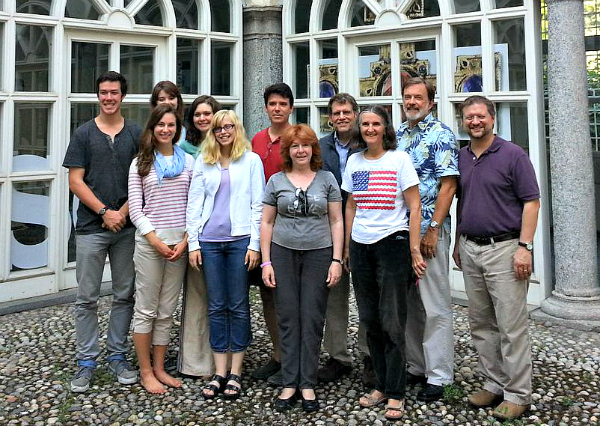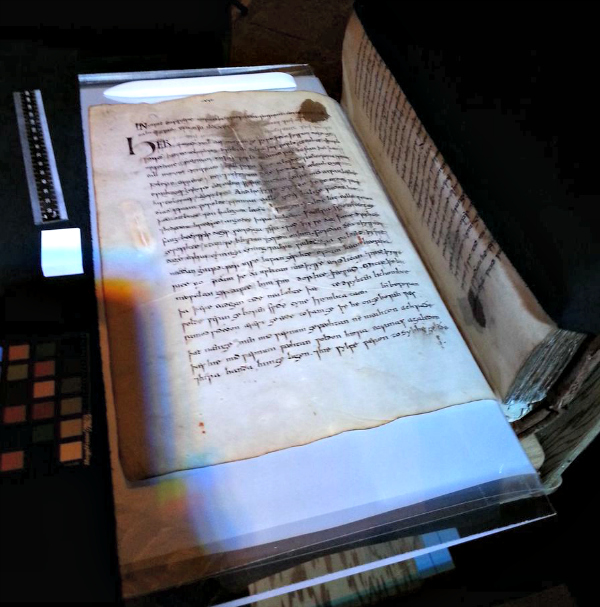
Back row, from left to right: William Boyles (UM), Eleanor Anthony (UM) Lizzie Wicks (UM), Gregory Heyworth (UM), Roger Easton (RIT), Keith Knox (USAF) and Michael Phelps (Early Manuscripts Electronic Library).
Front row: Meredith Oliver (UM), Liz Bondi (RIT), Ira Raabin (University of Hamburg) and Dale Knox.
A group of University of Mississippi students and their professor recently received a mention in the Vatican’s newspaper for their efforts to help restore an ancient Christian text known as “The Old Latin Gospels.”
The students and English professor Gregory Heyworth worked with Roger Easton, a professor of Imaging Science at the Rochester Institute of Technology, and Keith Knox, of the U.S. Air Force Research Lab in Maui, Hawaii. Ken Boydston, of Megavision, and Michael Phelps, of the Early Manuscripts Electronic Library, were also part of the team. As part of the Lazarus Project, the team restored the fourth century text of the first four books of the New Testament in Latin. The document is known as “Vercelli Codex Evangeliorum Vercellensis.”
The team reworked images that were collected over two weeks in Vercelli, Italy, to reproduce the text. Heyworth said the work was an immensely valuable experience for the students, who performed like seasoned professionals.
“After two years now of working directly with some of the rarest and most precious manuscripts in the world, the students of the Lazarus team behave like seasoned veterans,” Heyworth said. “All of them moved seamlessly among roles: manuscript handling, running the camera and imaging system and troubleshooting technical problems, setting up Wi-Fi hotspots, image processing, doing historical background research and aiding in the chemical analysis of texts using X-ray fluorescence.”
Heyworth said UM students William Boyles, Eleanor Anthony, Caleb Ezell, Lizzie Wicks and Meredith Oliver “are the vanguard of the next generation” of literary and historical scholars in the humanities.
“This cluster of skills, what I call textual science, is going to be the discipline of the next generation of literary and historical scholars in the humanities,” Heyworth said.
The text contains the New Testament books of Matthew, Mark, Luke and John. The last 12 verses of the Gospel of Mark are missing. The text, which is believed to have been crafted under bishop Eusebius of Vercelli’s direction, is written on purple vellum, a high-quality parchment. It’s believed to be the oldest surviving copy of the old Latin Gospels, which is a name given to Bible texts that were translated before Jerome’s Vulgate Bible was the standard for Latin-speaking Western Christians. Much of the text, which was often used in oath-taking ceremonies in the Middle Ages, had been lost, but gradually, painstaking efforts in the last two centuries have led to its restoration.
The Vatican’s newspaper, L’Osservatore Romano, reports the texts were combed over with a multispectral ultraviolet and infrared cameras, which captured a series of shots that were fed into special software. The high-resolution images, which were shot at different exposure times, create a range of pictures that are available to those involved in image processing. Only about five instruments in the world can do this job, Boydston told the L’Osservatore Romano.
The data required a long elaboration, headed by Liz Bondi, a student at the Rochester Institute of Technology, who has worked on some pages recently, palinseste code CXII (which dates from the 11th through 13th centuries), presenting figures related to some rolls preserved in the Library, dating from the Thirteenth Century, and probably used in the Eusebian schola to teach students the history of the Church, the Cardinal Sins, geometry and other topics that may be revealed through this virtual restoration.
Other students have worked on printed sources, confirming the fact that the manuscript is mutilated; in fact, following the regular numbering sequence (shows a lack of a double page on pages 601-602 and 615-616), but other double pages were missing even before the pagination. …
Today, in 2014, the manuscript is submitted to a different restoration, totally noninvasive, that will bring back to light approximately 90 percent of the writing penned by a scribe of the Fourth Century.
